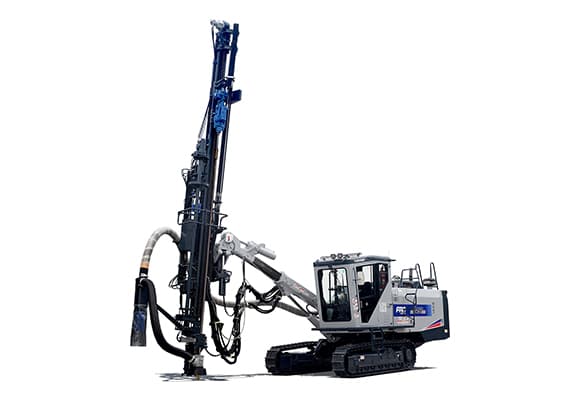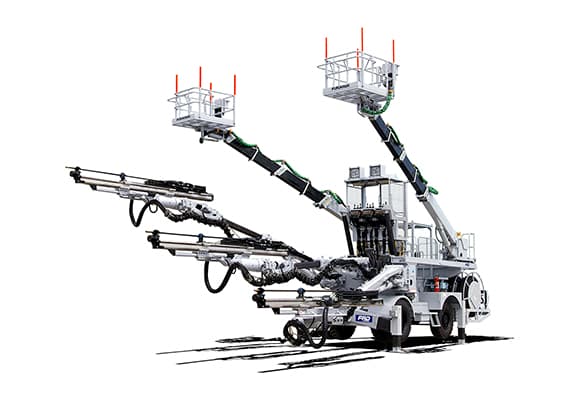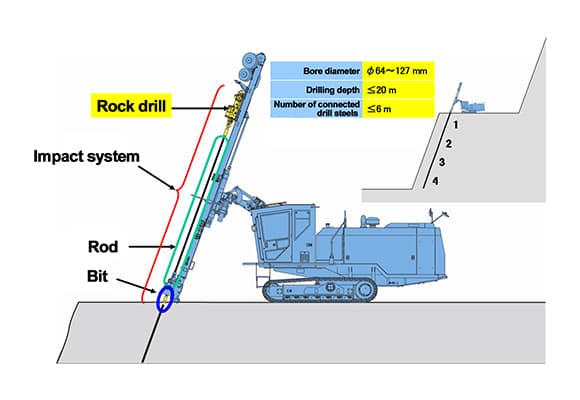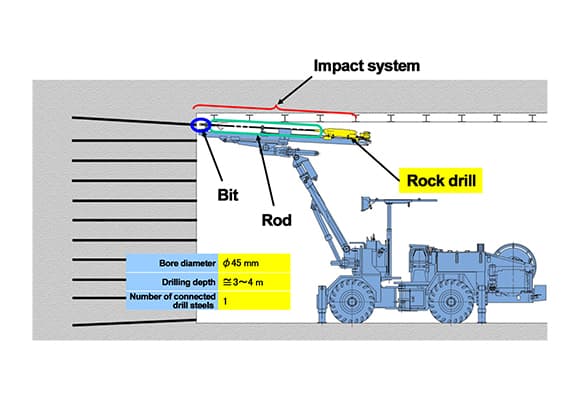1. Introduction
Furukawa Rock Drill (FRD) is a general rock drill manufacturer. This paper looks back at the history of rock drills, the product that we make, examines the technological changes that have occurred to create the rock drills we see today, and looks at the current technological trends in this field.
1.1. What Are Rock Drills?
Before discussing the way rock drills have changed over time, let us first define what exactly a rock drill is.
As you would imagine, a rock drill is a machine used to drill rock; that is, to make a hole in rock, and is mainly used to drill holes for charging gunpowder when blasting bedrock.
Rock drills are broadly classified into three types based on the drilling principle: top hammer drills, down-the-hole (DTH) drills, and rotary drills.
A top hammer drill has a long rod known as a drill string to which a bit is attached to the end. In the same way as a chisel is hit by a hammer, the top of the drill string is hit by a hammer known as a drifter, which crushes the rock.
A DTH drill has a drill string with a drifter attached to the end, which is located in the bottom of the hole. Rock is crushed by directly striking the bit attached to the drifter.
A rotary drill crushes rock by applying crushing force to the bit on the end of the drill string, which is pressing into the bedrock.
Although the placement of the drifter differs, with both top hammer drills and DTH drills, what contributes directly to bedrock crushing is exclusively impact. The percussive energy that is generated by the impact is transmitted to the bit in the form of stress waves (particle speed variations). The particle speed variations that occur very quickly at the bit tip allow the bit to penetrate the rock, crushing the bedrock. At that time, in order for the percussive energy to be reliably transmitted to the bedrock, the bit must stay in contact with the rock. For the bit to stay in contact with the rock, down pressure (thrust) must be applied to the drill string.
Rotary drills, on the other hand, make the bit penetrate the bedrock by quasi-statically pushing the bit into the bedrock. It is therefore the down pressure (thrust) on the bit that contributes significantly to crushing the bedrock.
If you compare the features of top hammer drills and DTH drills, drills for which impact directly contributes to crushing the bedrock, you can see that with top hammer drills, the drifter is placed at the top of the drill steel; that is, outside the hole. This means that there are few size constraints, and the shape of the piston (hammer) that is in contact with the target bedrock can be optimized to have approximately the same diameter as the drill string, which is ideal from an energy transmission efficiency viewpoint. It is also easy to use hydraulic and other high-power driving sources for the piston.
One downside, however, is that the deeper the hole, the more the impact energy attenuates as it is being transmitted along the drill string, which tends to lower the performance.
DTH drills, on the other hand, have the drifter located at the bottom of the hole. This means that there are significant size constraints, and compared to a top hammer drill, the piston diameter must be relatively smaller than the bore hole diameter. Moreover, because it would be difficult to remove a driving medium that was fed to a drifter located at the bottom of the hole, a pneumatic driving source that does not need to be removed is usually used for DTH drills, making them inferior to top hammer drills in terms of power.
On the other hand, as the drifter is located at the bottom and directly impacts the bit, the output remains stable regardless of the depth of the hole, giving DTH drills the advantage over top hammer drills in deep hole drilling.
With DTH drills also, because the drifter is located at the bottom of the hole, the bore hole diameter, and by extension the drill string diameter, can be wide, allowing for a more rigid drill string and straighter holes, which is also advantageous when drilling deep holes.






